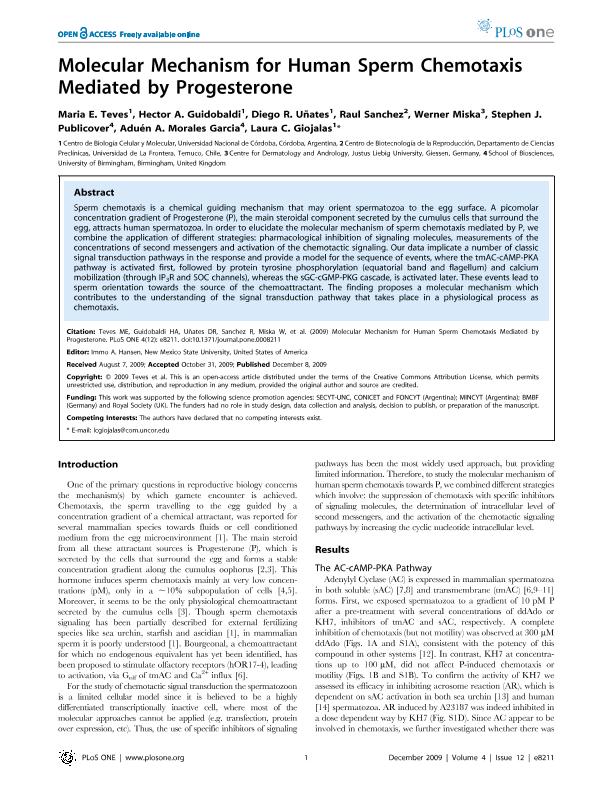Mostrar el registro sencillo del ítem
dc.contributor.author
Teves, Maria Eugenia

dc.contributor.author
Guidobaldi, Héctor Alejandro

dc.contributor.author
Uñates, Diego Rafael

dc.contributor.author
Sánchez, Raúl Oscar

dc.contributor.author
Miska, Werner
dc.contributor.author
Publicover, Stephen J.
dc.contributor.author
Morales Garcia, Aduén A.
dc.contributor.author
Giojalas, Laura Cecilia

dc.date.available
2018-09-14T16:37:24Z
dc.date.issued
2009-12
dc.identifier.citation
Teves, Maria Eugenia; Guidobaldi, Héctor Alejandro; Uñates, Diego Rafael; Sánchez, Raúl Oscar; Miska, Werner; et al.; Molecular mechanism for human sperm chemotaxis mediated by progesterone; Public Library of Science; Plos One; 4; 12; 12-2009
dc.identifier.issn
1932-6203
dc.identifier.uri
http://hdl.handle.net/11336/59690
dc.description.abstract
Sperm chemotaxis is a chemical guiding mechanism that may orient spermatozoa to the egg surface. A picomolar concentration gradient of Progesterone (P), the main steroidal component secreted by the cumulus cells that surround the egg, attracts human spermatozoa. In order to elucidate the molecular mechanism of sperm chemotaxis mediated by P, we combine the application of different strategies: pharmacological inhibition of signaling molecules, measurements of the concentrations of second messengers and activation of the chemotactic signaling. Our data implicate a number of classic signal transduction pathways in the response and provide a model for the sequence of events, where the tmAC-cAMP-PKA pathway is activated first, followed by protein tyrosine phosphorylation (equatorial band and flagellum) and calcium mobilization (through IP3R and SOC channels), whereas the sGC-cGMP-PKG cascade, is activated later. These events lead to sperm orientation towards the source of the chemoattractant. The finding proposes a molecular mechanism which contributes to the understanding of the signal transduction pathway that takes place in a physiological process as chemotaxis. © 2009 Teves et al.
dc.format
application/pdf
dc.language.iso
eng
dc.publisher
Public Library of Science

dc.rights
info:eu-repo/semantics/openAccess
dc.rights.uri
https://creativecommons.org/licenses/by-nc-sa/2.5/ar/
dc.subject
Chemotaxis
dc.subject
Molecular Mechanism
dc.subject
Progesterone
dc.subject.classification
Otras Ciencias Biológicas

dc.subject.classification
Ciencias Biológicas

dc.subject.classification
CIENCIAS NATURALES Y EXACTAS

dc.title
Molecular mechanism for human sperm chemotaxis mediated by progesterone
dc.type
info:eu-repo/semantics/article
dc.type
info:ar-repo/semantics/artículo
dc.type
info:eu-repo/semantics/publishedVersion
dc.date.updated
2018-07-23T17:56:05Z
dc.journal.volume
4
dc.journal.number
12
dc.journal.pais
Estados Unidos

dc.journal.ciudad
San Francisco
dc.description.fil
Fil: Teves, Maria Eugenia. Universidad Nacional de Córdoba. Facultad de Ciencias Exactas, Físicas y Naturales. Centro de Biología Celular y Molecular; Argentina
dc.description.fil
Fil: Guidobaldi, Héctor Alejandro. Consejo Nacional de Investigaciones Científicas y Técnicas. Centro Científico Tecnológico Conicet - Córdoba. Instituto de Investigaciones Biológicas y Tecnológicas. Universidad Nacional de Córdoba. Facultad de Ciencias Exactas, Físicas y Naturales. Instituto de Investigaciones Biológicas y Tecnológicas; Argentina
dc.description.fil
Fil: Uñates, Diego Rafael. Consejo Nacional de Investigaciones Científicas y Técnicas. Centro Científico Tecnológico Conicet - Córdoba. Instituto de Diversidad y Ecología Animal. Universidad Nacional de Córdoba. Facultad de Ciencias Exactas Físicas y Naturales. Instituto de Diversidad y Ecología Animal; Argentina
dc.description.fil
Fil: Sánchez, Raúl Oscar. Universidad de La Frontera; Chile
dc.description.fil
Fil: Miska, Werner. Justus Liebig University; Alemania
dc.description.fil
Fil: Publicover, Stephen J.. University of Birmingham. School of Biosciences; Reino Unido
dc.description.fil
Fil: Morales Garcia, Aduén A.. University of Birmingham. School of Biosciences; Reino Unido
dc.description.fil
Fil: Giojalas, Laura Cecilia. Consejo Nacional de Investigaciones Científicas y Técnicas. Centro Científico Tecnológico Conicet - Córdoba. Instituto de Investigaciones Biológicas y Tecnológicas. Universidad Nacional de Córdoba. Facultad de Ciencias Exactas, Físicas y Naturales. Instituto de Investigaciones Biológicas y Tecnológicas; Argentina
dc.journal.title
Plos One

dc.relation.alternativeid
info:eu-repo/semantics/altIdentifier/doi/http://dx.doi.org/10.1371/journal.pone.0008211
dc.relation.alternativeid
info:eu-repo/semantics/altIdentifier/url/https://journals.plos.org/plosone/article?id=10.1371/journal.pone.0008211
Archivos asociados
